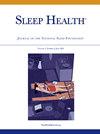阻塞性睡眠呼吸暂停在改变慢波活动和提高阿尔茨海默病风险方面的中介作用:来自台湾北部队列的试点研究。
IF 3.4
2区 医学
Q2 CLINICAL NEUROLOGY
引用次数: 0
摘要
目的:阻塞性睡眠呼吸暂停与睡眠中慢波活动的改变有关,可能会增加阿尔茨海默病的患病风险。本研究调查了阻塞性睡眠呼吸暂停表现(如呼吸事件、缺氧、唤醒、慢波模式和神经化学生物标志物水平)之间的关联:方法:对疑似阻塞性睡眠呼吸暂停患者进行多导睡眠图检查。方法:对疑似阻塞性睡眠呼吸暂停患者进行多导睡眠图检查,获取睡眠障碍指数、血氧指标和慢波活动数据,并于次日早晨采集血样,采用超灵敏免疫磁还原法测定血浆中总 tau(T-Tau)和淀粉样β肽 42(Aβ42)的水平。随后,根据计算得出的 Aβ42 × T-Tau 乘积,将参与者分为阿尔茨海默氏症低风险组和高风险组。对组间差异以及睡眠相关参数与神经化学生物标志物之间的关联和中介效应进行了分析:42名参与者分别被分配到低风险组和高危组各21人。与低风险人群相比,高风险人群的呼吸暂停-低通气指数、血氧饱和度指数(≥3%,ODI-3%)、血氧饱和度不达标的总睡眠时间比例(SpO2-90% TST)和唤醒指数更高,慢波活动的峰-峰振幅和斜率更大,持续时间相应更短。此外,研究还发现呼吸暂停-低通气指数、ODI-3%和SpO2-90% TST等指数会间接影响慢波活动,从而提高Aβ42 × T-Tau水平:结论:阻塞性睡眠呼吸暂停的表现,如呼吸事件和缺氧,可能会影响慢波睡眠活动(起中介作用),并可能与神经化学生物标志物水平升高有关。然而,有必要进行纵向研究,以确定这些因素之间的因果关系:这项研究旨在弥补人们在理解阻塞性睡眠呼吸暂停与阿尔茨海默病风险升高之间的关系方面存在的空白,为睡眠和认知健康提供有价值的知识。本文章由计算机程序翻译,如有差异,请以英文原文为准。
Mediating role of obstructive sleep apnea in altering slow-wave activity and elevating Alzheimer’s disease risk: Pilot study from a northern Taiwan cohort
Objectives
Obstructive sleep apnea is associated with alterations in slow-wave activity during sleep, potentially increasing the risk of Alzheimer’s disease. This study investigated the associations between obstructive sleep apnea manifestations such as respiratory events, hypoxia, arousal, slow-wave patterns, and neurochemical biomarker levels.
Methods
Individuals with suspected obstructive sleep apnea underwent polysomnography. Sleep disorder indices, oxygen metrics, and slow-wave activity data were obtained from the polysomnography, and blood samples were taken the following morning to determine the plasma levels of total tau (T-Tau) and amyloid beta-peptide 42 (Aβ42) by using an ultrasensitive immunomagnetic reduction assay. Subsequently, the participants were categorized into groups with low and high Alzheimer’s disease risk on the basis of their computed product Aβ42 × T-Tau. Intergroup differences and the associations and mediation effects between sleep-related parameters and neurochemical biomarkers were analyzed.
Results
Forty-two participants were enrolled, with 21 assigned to each of the low- and high-risk groups. High-risk individuals had a higher apnea–hypopnea index, oxygen desaturation index (≥3%, ODI-3%), fraction of total sleep time with oxygen desaturation (SpO2-90% TST), and arousal index and greater peak-to-peak amplitude and slope in slow-wave activity, with a correspondingly shorter duration, than did low-risk individuals. Furthermore, indices such as the apnea–hypopnea index, ODI-3% and SpO2-90% TST were found to indirectly affect slow-wave activity, thereby raising the Aβ42 × T-Tau level.
Conclusions
Obstructive sleep apnea manifestations, such as respiratory events and hypoxia, may influence slow-wave sleep activity (functioning as intermediaries) and may be linked to elevated neurochemical biomarker levels. However, a longitudinal study is necessary to determine causal relationships among these factors.
Statement of significance
This research aims to bridge gaps in understanding how obstructive sleep apnea is associated with an elevated risk of Alzheimer’s disease, providing valuable knowledge for sleep and cognitive health.
求助全文
通过发布文献求助,成功后即可免费获取论文全文。
去求助
来源期刊

Sleep Health
CLINICAL NEUROLOGY-
CiteScore
6.30
自引率
9.80%
发文量
114
审稿时长
54 days
期刊介绍:
Sleep Health Journal of the National Sleep Foundation is a multidisciplinary journal that explores sleep''s role in population health and elucidates the social science perspective on sleep and health. Aligned with the National Sleep Foundation''s global authoritative, evidence-based voice for sleep health, the journal serves as the foremost publication for manuscripts that advance the sleep health of all members of society.The scope of the journal extends across diverse sleep-related fields, including anthropology, education, health services research, human development, international health, law, mental health, nursing, nutrition, psychology, public health, public policy, fatigue management, transportation, social work, and sociology. The journal welcomes original research articles, review articles, brief reports, special articles, letters to the editor, editorials, and commentaries.
 求助内容:
求助内容: 应助结果提醒方式:
应助结果提醒方式:


